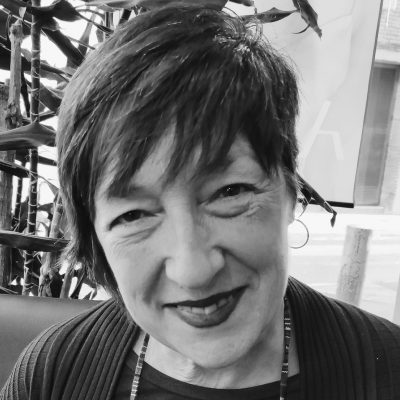Part II: South Asia
Chapter 6: The “City” and “The Easy Life”: Work and Gender among Sherpa in Nepal
Alba Castellsagué and Silvia Carrasco
In this chapter, the authors examine the ongoing poverty of the region that has been the focus of many international development plans and efforts. The authors explore the impact some of these development projects have had on work patterns among ethnic Sherpa women in Nepal. They question whether or not wage labor and urban lifestyles with Western patterns of consumption (the markers of development) actually contribute to women’s emancipation and empowerment.
- Analyze the gender dimensions of work inequalities through the case of Sherpa in Nepal.
- Identify the gendered effects of mobility.
- Define key concepts such as gender and mobility regimes, sexual division of labor, and productive and reproductive work.
Waged labor has become a central focus in development issues around the world, particularly as it relates to women’s equality and emancipation. For example, if we look at the United Nations’ Millennium Development Goals, participation in the labor force and having paid work outside of agriculture are both indicators of achievement for goal number three: “promote gender equality and empower women” (United Nations 2010). Similarly, the Global Gender Gap Report measures variables such as female labor force, wage equality, and earned income (World Economic Forum 2017), with the goal of reducing the gap between male and female economic participation and opportunities. However, as this chapter demonstrates, wage labor is not always the best or only path to women’s equality or emancipation.
Multiple studies (Escobar 1998; Hirschman 1980; Sen 1999) have challenged the idea that development should solely be based on material and economic growth, and indeed as our study shows, analyzing development from a gender perspective highlights the problems of such a view. First, economic growth has been based on specific models of material development and the subsequent promotion of women as efficient, wage-earning workers. These ideas of women as ideal workers “are embedded in, rely on, and actively reinforce and extend the existing patriarchal structures and gendered relationships of power” (Wilson 2015, 807). Not only do the global production processes and labor markets reproduce an unequal distribution of power between men and women, but they are increasingly made precarious by the dominant neoliberal economies and policies (Mills 2003; Peterson 2016). Second, economic growth is also “defined and measured in a way that arbitrarily excludes the essential, but invisible ‘economic inactivity’ that goes into making it happen” (Kabeer 2016, 298). The gendered division of labor is therefore essential to unpack and understand gender inequalities, and it has historically been at the center of feminist research and vindications.
In Nepal, changing modes of production and living under the urban-development paradigm have provoked a rapid transformation of social structures and hierarchies, including gender. In this chapter we specifically explore the constant (re)shaping of the meanings and patterns of work for Sherpa women, drawing on data from a multisited ethnography (Marcus 1995) in Gaun and Kathmandu.
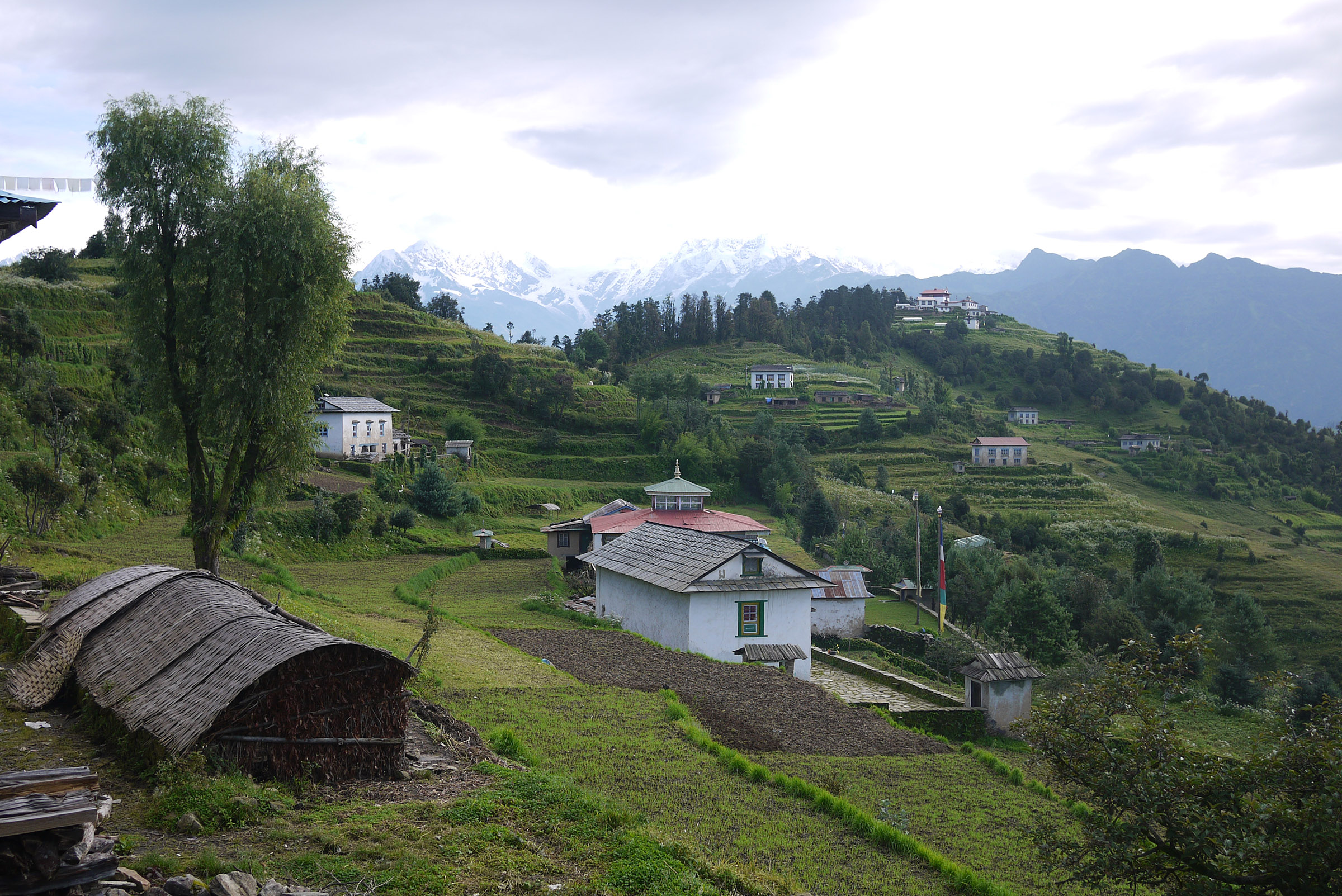
Gaun is a small village located at an altitude of thirty-four hundred meters in the Solu region of the Himalayan mountains in Nepal. The village includes roughly twenty households settled around cultivation terraces, three Buddhist monasteries, and a primary school. Its population is mostly Sherpa, an ethnicity native to the mountainous regions in the north and the east of Nepal. Sherpas are 0.43 percent of the population of Nepal (Nepal Population Report 2016), have Tibeto-Burman origins, and are typically engaged with Buddhist traditions. For their knowledge of high-altitude areas and particularly within the Everest region, they are highly regarded and well known as expert mountain climbers. In fact, the term Sherpa is nowadays often misused to refer to any mountain guide or expedition staff member in the Himalayas, regardless of their ethnicity. Most of our informants often move between Gaun and Kathmandu, due to work or school requirements, to visit relatives, and/or for seasonal or temporary changes of residence. The importance of this mobility led us to the multisited approach to our ethnography, allowing us to consider not only both geographic contexts but also the variety of processes relevant to women’s mobility flows. Kathmandu is the largest metropolitan area of the Himalayas and the capital city of Nepal. It has the hustle and bustle typical of big cities: noisy, dusty, and busy streets; markets of all kinds; and also temples from diverse religious traditions—all of these attract not only foreign tourists but also pilgrims from all over Nepal.
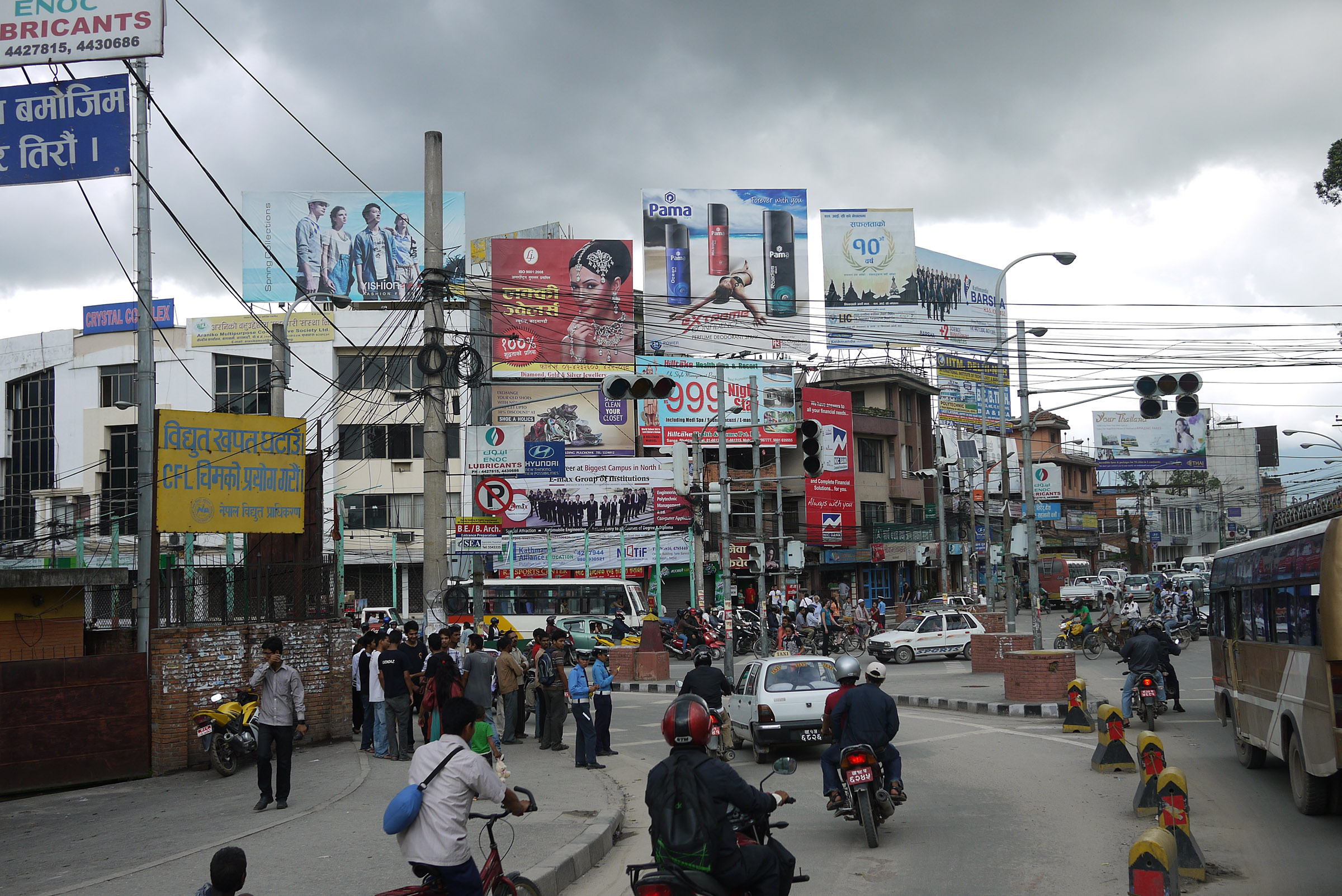
Our fieldwork in both locations centered on issues of women’s work, specifically (1) the construction of femininity and social relations in Gaun, (2) women’s narratives on education and development (Castellsagué and Carrasco, 2020b), and (3) women’s expectations and desires for mobility in urban settings, both within Nepal and abroad.
Work: A Driver for Women’s Development in Nepal
This chapter focuses on three important labor factors from a gender perspective among Sherpas in Nepal. Firstly, there are the continuing ethnic differentiations of women’s participation in wage labor. Second, the dominant development discourses situate “modern” wage labor as desirable, particularly for women, who are usually considered by development organizations as independent or empowered if they participate in the productive economy and bring a monetary income to the household. Finally, government and international organizations promote wage labor over other traditional activities such as subsistence farming, as the Nepal Human Development Report (2014) emphasizes: “The pace of economic growth needs to accelerate, and be accompanied by large-scale employment generation and enhanced productivity” (3). In Nepal, although women represent 53 percent of the employed population, there’s a significant gender gap when it comes to wage employment—only 8.3 percent are paid—women are overrepresented in the informal sector (including unpaid family workers, unpaid apprentices, and part-time workers) and low-skilled jobs (Acharya 2014). According to the Gender Gap Report, Nepal ranks high among countries in terms of female workforce participation (16th out of 144) but fares much worse when it comes to wage equality for women where it ranks much lower (98th out of 144) for all workers, and 115th out of 144 for professional and technical workers) (World Economic Forum 2017). If we take a more qualitative approach, we see that the organization of female labor reflects Nepal’s ethnic and cultural diversity. Acharya and Bannett (1983) noted two differentiated patterns: while the Hindu communities concentrated female labor within domestic work and subsistence production, Tibeto Burman communities, such as Sherpa, showed a higher degree of female participation in the market economy and a more significant role in household economic decisions. Despite dramatic changes in the modes of production in Nepal and the organization of women’s labor organization, we found that the patterns described by Acharya and Bennett (1983) still persist.
Mobility is the second (and intimately related) factor as women’s movements are tied to job-seeking opportunities (Hagen-Zanker et al. 2014). As we have argued (Castellsagué, forthcoming), a particular mobility regime in Nepal, embedded within the hegemonic development paradigms, promotes certain flows to urban centers and abroad, mainly to more developed countries (e.g., the Gulf States, Southeast Asia, and India (Maharjan, Bauer, and Knerr 2012; Government of Nepal and Ministry of Labour and Employment 2016). This chapter examines an often-overlooked aspect of mobility, namely the linkage between internal and external migration from a gender perspective. International migration, which is predominantly masculine, is closely tied to national and internal patterns of wives’ mobility to the urban centers (Maharjan 2015). Women are increasingly participating in such mobility dynamics and are no longer seen as mere administrators of remittances. Rather, they have an active role in the economic and labor strategies in Nepal and abroad (Hamal Gurung 2015).
Finally, young women see education as a strategic access door to wage labor and modern lifestyles, which mostly means being educated, living in a city or abroad, and participating in the wage labor force. Harber (2014) maintains that the promise of access to the labor market, as well as of better jobs and income, is at the core of schooling discourses and constitutes one of the main drivers in the promotion of education in Nepal.
The education system is being viewed as being “successful” only when a student graduates and secures the job that will take him or, rarely, her out of the village with its traditional values and into the city with its modern lifestyle. (Wynd 1999, 107)
To continue their education, young people must move to Kathmandu or abroad, adapting to more urban livelihoods and job expectations.
Life in Gaun
“It’s hard work, but we’re satisfied,” stated Amita, a thirty-year-old woman who lives in Gaun with her younger son and daughter. Her eldest son lives with her extended family in a nearby village, and her husband spends weekdays in another village where he is employed as the school principal. The organization of work in Gaun is based on a sexual division of labor. As Dolma, fifty-eight, describes it, “Women are always busy with the home, the culture. Men work to make the money, they go to the Himalaya, trekking, ride a car in Europe . . . they want to be rich; after all, daily life is carried on by women.” Note that Dolma uses the expression “ride a car in Europe” and links it to the idea of being rich; that is, being able to afford a car in Europe and ride it. Everyday life in Gaun for women includes working in the fields, taking care of the animals (usually cows or goats), fetching water for the kitchen, sharing tea and chatting with other women, exchanging products with other families, and visiting relatives, among other activities. Some women, such as Amita or Mingma, also work as teachers in Gaun’s school; while others own small shops with basic goods or host guests at their households as forms of business. For men, everyday life can vary depending on their work: they pray and make puja (ceremonies) if they are lamas (Buddhist monks), they guide trekking expeditions, or work in the school if they are teachers. They also work in the construction sector and take care of the livestock. In the periods between work assignments, they socialize with other men and work in the crops with their relatives.
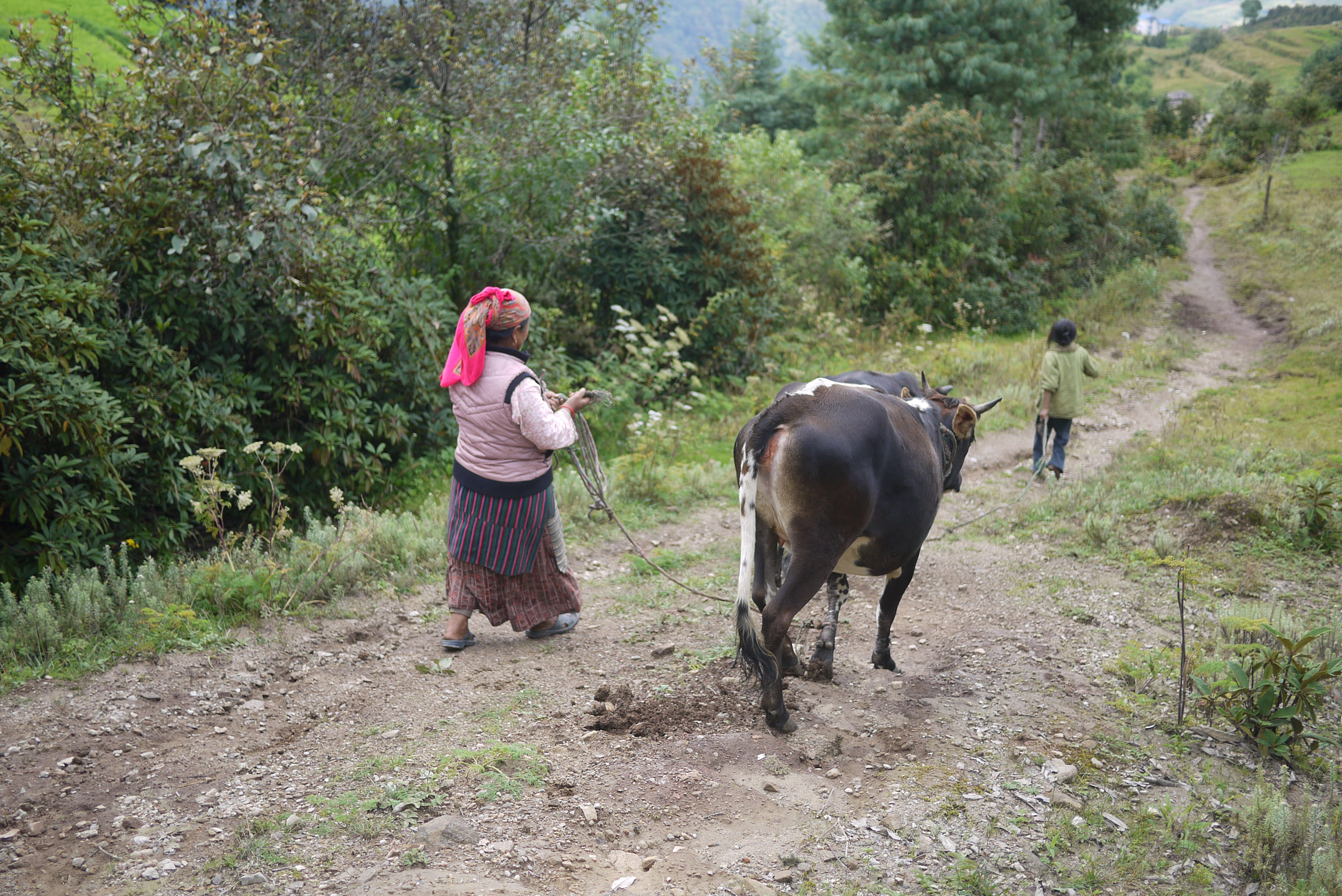
We quickly noticed that the masculine and feminine spheres are significantly separated in Gaun. The spaces of socialization, the type of work, and the daily activities are organized according not only to sex but also age. Men and women carry out different activities and spend most of the time with their gender equals, while age is used to assign roles within the family and the crop production. Both factors, age and gender, appear to be intertwined, not only for the organization of daily chores but also for the transference of knowledge and social responsibilities. This makes the case for an intersectional approach in our analysis.
Women never viewed the separate gendered spheres of work and socialization as a disadvantage. Due to the work women perform, they also play a central role in resource management and decision making, both within the family unit and the village (Tamang 2000). Their capacity of work is an essential component of the valuation of femininity in Gaun. They consider a “real Sherpa” to be a woman who is strong, both physically and in character, self-confident, and capable of working hard. While working in the fields, women also create strong networks through which they help each other and develop a sense of community (see figure 6.4).
In their workspaces, including the households, they make decisions about social issues. Whenever something happens in Gaun, whether it is a political, economic, or community issue, women informally gather at some household or in a field, and while sharing tea or working together they evaluate the situation, exchange opinions, and usually come up with an agreement on how to address the issue at hand (see figure 6.5). Work becomes an aspect of women’s identities, something for which they are socially valued and respected; their labor is much more than just an economic contribution.
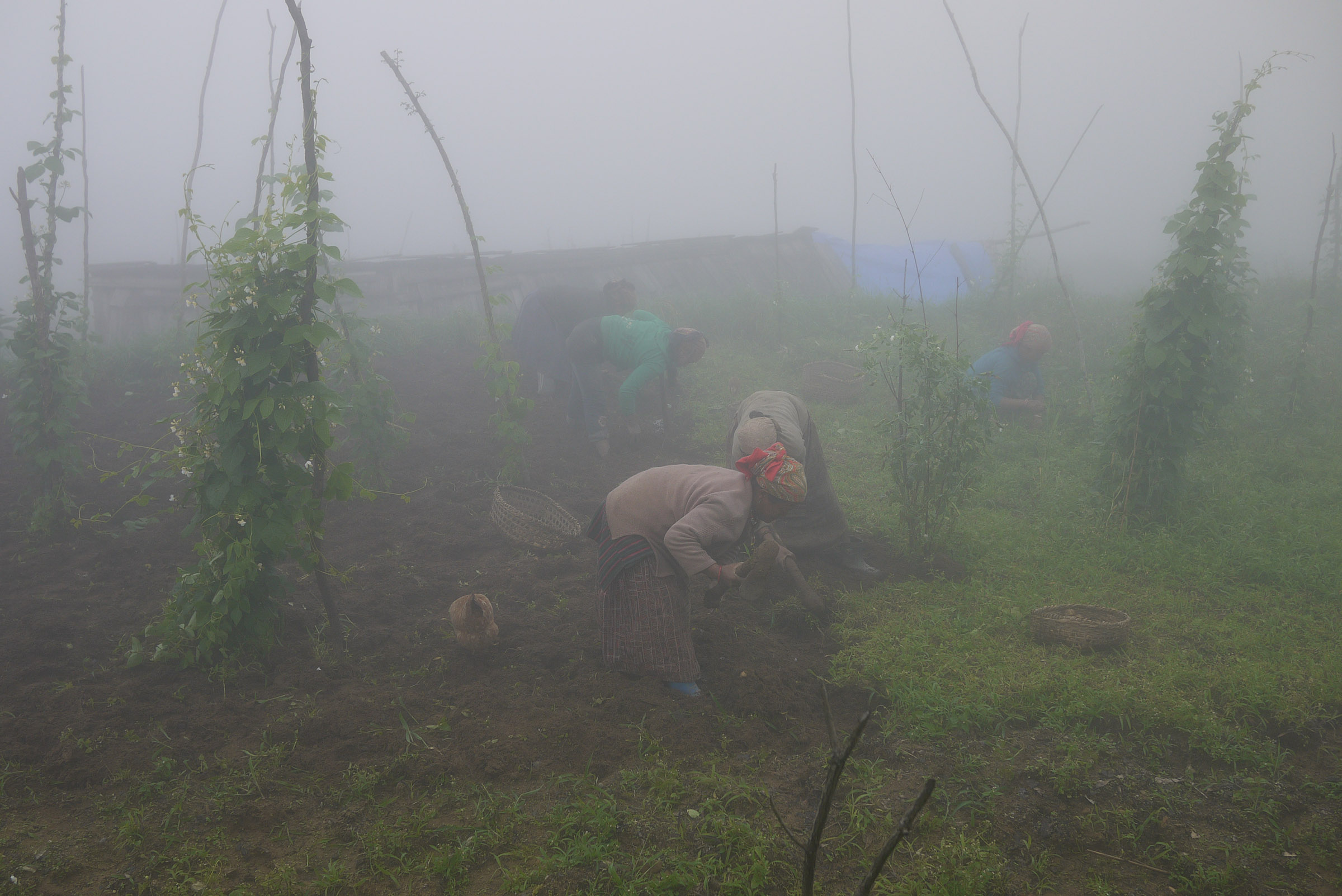
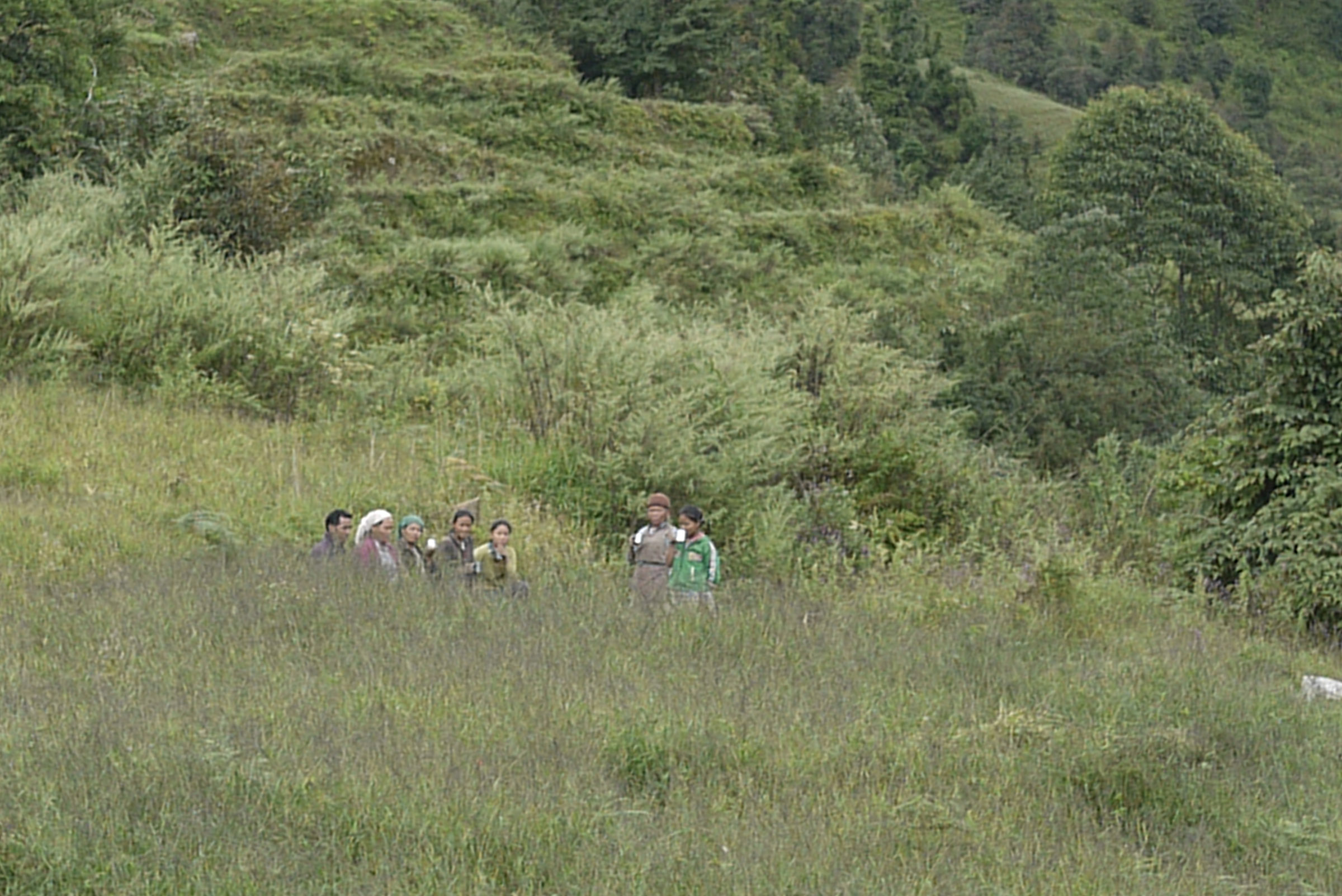
If we think about other intrinsic factors, women nowadays carry the majority of the burden of both household and village work due to long absences of men and young people who are away for work or education. The majority of families in Gaun lack some of their male members, either permanently or temporarily. We learn of them through phone calls, photographs, and the many stories we hear from their wives, children, and relatives. Men pursue paid jobs in the mountain region (trekking, expeditions), Kathmandu (work in an office or restaurant), or abroad (mostly construction). Young boys and girls move for educational purposes, as the possibilities for further study are better in the larger cities of Nepal. Male internal migration has an impact on the way work is organized, experienced, and signified by women in Gaun. Productivity decreases due to the lack of laborers, many fields and houses are left unoccupied, and women, both adult and elderly, take an active role in most of the work in Gaun. Amita describes her daily chores, which are “to carry water from the riverside, look after the babies, feed them, look after the animals, work in the fields, cooking, host guests.” A common feeling among women, particularly younger women, is that “life is hard in Gaun, because we have to do a lot of work,” as the fifteen-year-old Manju states. Other informants also refer to life as gharo (hard or difficult) in Gaun because of the lack of amenities. Amita observes that “there is no access to a market, it is hard to bring basic goods and there’s a lack of infrastructure, such as electricity.” Therefore, the difficulties among Sherpa women encompass not only the amount of work to be done but also the burdens they face due to poor infrastructure and the absence of men. Age, gender, and men’s national and international migration are relevant factors in shaping the design and development of women’s mobility projects and their perceptions of life. As we will see in the next section, the perception of rural life as “hard” is usually based on comparisons with urban life either experienced or only imagined.
Life in the City
The reasons for moving to Kathmandu are diverse, depending on each family’s situation and their particular mobility projects. However, as men migrate to seek better job opportunities, women may also try to avoid relatively unproductive and hard agricultural labor by moving to urban areas, usually to educate children (Maharjan, 2015). We can identify common themes in the organization of work among the families, as well as the way women experience and perceive city life.
Sherpa women have very good facilities here [in the city], and they don’t have to work. Most of [the} Sherpa women that stay in Kathmandu, their husbands are abroad, in Dubai, Malaysia, Qatar . . . you know? And they earn money, and they send them (remittances). And the woman’s job is only to look after their kids, and look after herself also. Only this. (Mingma, twenty-three years old)
As we notice through Mingma’s statement, daily life is notably different for Sherpa women in Kathmandu. She points out some transformations in the organization of work in urban settings, compared to rural life in Gaun. First, life is perceived as much more sagilo (easy) for women in the city due to access to better amenities. Although she recognizes that women, due to the absence of men, are still the ones that do all the work, the fact of being in an urban environment and having money completely changes her interpretation of work and its difficulty. She feels that they “only” have to perform reproductive tasks. Dolma also stresses the importance of money in order to reduce the burden of work in the city by saying that “if you have money in the city you can buy everything, you can order food from home, and in the village you have to do it yourself.” Men’s internal migration is relevant, as their remittances may seem more useful for women in an urban setting, where money can be put to better use. On the other hand, extra money in Gaun does not necessarily contribute to an easier life for women, at least not as they perceive it. We can also see how while in Gaun concepts of “work” did not differentiate between productive and reproductive labor, in Kathmandu such distinctions are meaningful. Reproductive work in Kathmandu is not just seen as “easier” work but not even considered work at all.
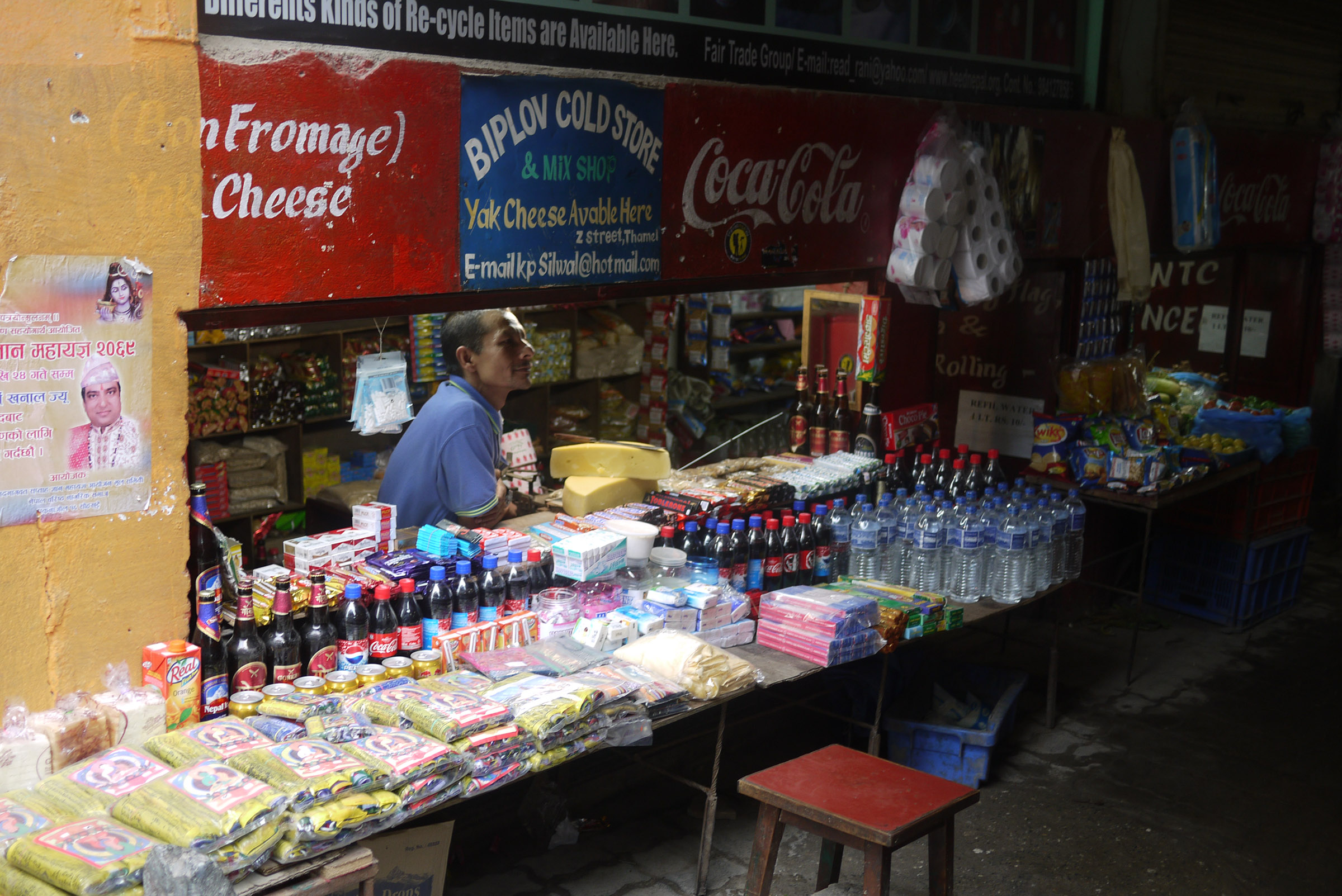
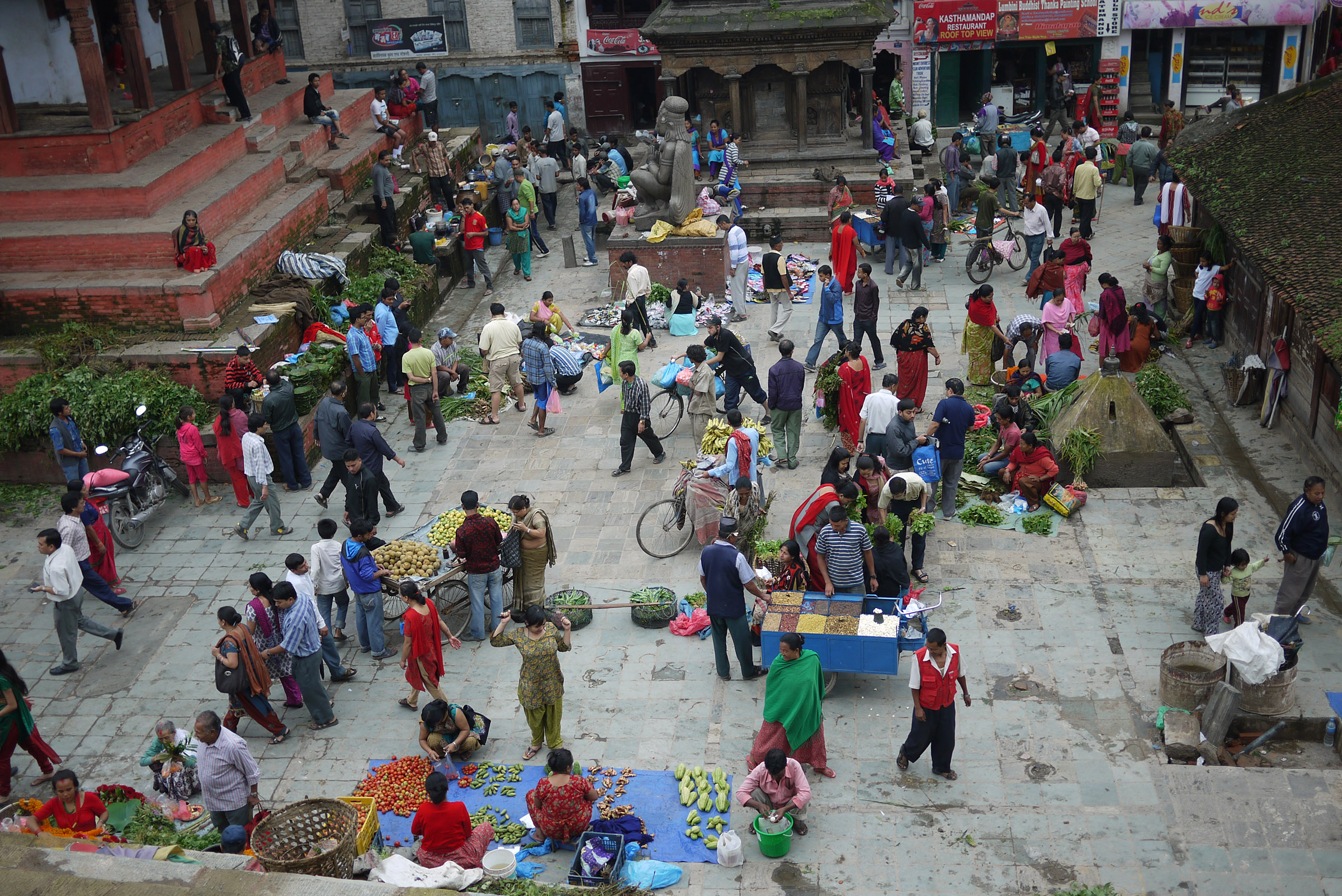
Working less is perceived as an improvement in women’s daily lives. However, if we consider how central work is for their self-worth and identity, we must consider whether such changes have other effects in their social lives and relationships. As we noted, life in the city is much more isolated than in Gaun; in fact it represents a loss of social ties and support networks for women living in Kathmandu. Dolma often expresses a feeling of loneliness, while other women feel that they have “nothing to do.” Interestingly, while working less is central to the idea of life as being “easier,” the informants also see the feeling of “not working at all,” in Dolma’s own words, as problematic.
Thus, mobility to access urban centers, often embedded within larger mobility projects and men’s international migration, shapes the patterns of Sherpa social organization. Women shift from a heavy combination of productive and reproductive work in Gaun to doing mainly household work in the city. With this change in work patterns, women need to (re)think and (re)orient their position and role within the family and the community.
High Expectations versus Poor Opportunities
Within mainstream development discourse, the city is imagined and portrayed as full of opportunities for women to engage global economies. When asking the young girls from Gaun about their expectations for the future, the majority of them aimed to live in Kathmandu or abroad. Many hoped to keep studying or to work as teachers, nurses, or social workers. Education is therefore seen as a useful tool to access to better job opportunities and gain sources of income (Castellsagué and Carrasco 2020). We found these common ideas embedded in notions of development such as productivity and the promotion of an urban-centered economy that prevail in Nepal to have particular gendered interpretation among our participants.
Boys can get any job. In the village they can work as a porter, as a trekking guide, as a cook . . . Even if they are uneducated they can get this kind of job easily. In Kathmandu also, they can be a driver, work in the construction. Even abroad, they can do any work. Girls . . . girls they can’t. If you are a girl, you have to get good education to get any job. (Mingma, twenty-three years old)
Mingma talks about how education becomes more meaningful for girls, who need it to compete for a job in the labor market. Since “jobs for boys” are often low skilled and can be accessed without any formal training, Mingma feels that girls need education to access “girls’ jobs,” such as teaching, working in a call center, or working as an administrative assistant. From an intersectional approach, we see how education is not only meaningful but is also considered valuable along gendered lines.
Nonetheless, one of the frequently mentioned challenges that young women living in the city face is the difficulty of getting jobs.
The problem is that everyone wants to come to Ktm [Kathmandu] to study further and to do something, but they can’t because it is very hard, you know? The person who has a bachelor pass or something like this, they can’t find a job. So it is very difficult here. (Mingma, twenty-three years old)
As Mingma explains, even having success in school does not guarantee that women will have access to formal jobs in the city. Therefore, the expectations that link schooling in the urban environment to direct access to productive jobs are not always fulfilled.
New Problems, Creative Alternatives
We have identified the ways women’s lives and expectations have changed and been (re)shaped by mobility and access to urban centers. Within their new circumstances in the cities, women face new positions and roles that they need to (re)negotiate and (re)signify in dialogue with their changing individual and social identities.
Facing the difficulties in pursuing job opportunities within the formal labor market, most of the informants have devised creative solutions. The majority of them have, in fact, a part-time job or run businesses in Kathmandu. “Sherpini [Sherpa women] always are looking for a side job, even in Kathmandu,” Dolma explains. She works as a volunteer, translator, and is a social activist. Other women prepare chang (homemade alcohol), momo (sherpa dumplings) or ghe (homemade butter) and sell it in the neighborhood, or they import products from the village and distribute them in Kathmandu. Mingma’s mother works in the family restaurant, and Jangmu owns a tea house in Boudhanath, the city’s Sherpa neighborhood. Their jobs are usually circumscribed within the informal sector, and they are obtained through the (re)activation of social networks, often built on the basis of a common village origin or kinship. “From home to home. With the phone we call the houses and ask what they need. We buy and sell through our own networks,” Dolma explains.
Women might seem somehow caught in a paradox. Despite their opinions highlighting a predilection for the “good” and “easy life” of the city, they have also expressed the need or desire to feel themselves active beyond the household. Dolma summarizes some of her reasons:
Money is important for independence. If you keep money you can have power. But it is also good for mental health and depression. You can see other women suffer from these, but the Sherpa we suffer much less, because we keep our minds busy, active, and we never stop working. You have to hold business. Also through work we can have connections with European people, while if you stay home you never get that. I’m almost 60 and I travel, I make new friends. I feel great! (Dolma, fifty-eight years old)
We see how working beyond the household continues to be meaningful for Sherpa women. While women are attracted to city life for the infrastructure and less work burden, they also do not settle for a role that only encompasses reproductive work and domestic chores.
(Re)questioning Work and the Emancipation of Women
This chapter has analyzed the transformations of work culture and organization between rural and urban environments, challenging the dominant development paradigm that links particular kinds of work (productive) and lifestyles (urban) with women’s empowerment and emancipation.
Our results confirm classic research that unpacks how a particular ideal of a “good” and “easy” life was, and still is, linked to development, which promotes urban settlement and productive work. By contrast, manual labor and agriculture are seen as “too hard,” a fact that we interpret as a way of devaluing these rural modes of production. Moreover, this chapter specifically analyzes this phenomenon from a gender perspective, questioning the pertinence and relevance of the dichotomy between productive and reproductive work. In rural contexts, daily life includes multitasking activities, which according to Aikman are “characteristic of women’s work and belies sharp divisions between household tasks and productive tasks” (1999, 71). However, such task differentiation becomes more relevant when women move to Kathmandu and they start to integrate the discriminatory logic of the capitalist sexual division of labor (Rosaldo 1979; Federici 2012): that is, not valuing as work the reproductive activities they do and reducing the variety of participation and socialization spaces to the domestic sphere.
The supposed emancipation that comes through participation in productive wage labor needs to be reconsidered. Although research has shown a clear increase in women’s participation in the labor market in terms of quantity, it is not clear what they have gained in terms of quality (Kabeer 2016). It is important to assess whether participation in the labor market, in the cases where participation is successfully achieved, is actually an improvement in women’s life conditions, since the workplace has been set as another patriarchal space and is broadly segregated along horizontal and vertical lines (Mills 2003; Kabeer 2015, 2016; Wilson 2015). Gender segregation in employment refers to men and women’s unequal distribution of access and performance within a certain occupational structure (a company, an economic sector, a state). Vertical segregation refers to the concentration of men at the top of the power hierarchies; while horizontal segregation is used when the segregation is based on the tasks both men and women do. Moreover, this push for development relies on a very narrow idea of work, which undervalues and excludes the multiple subsistence activities (e.g., agriculture and livestock, manual labor) that are considered unproductive (Shiva 1989). Feminism has historically challenged the very idea of salaried jobs as liberating (Federici 2004) and reclaimed that reproductive tasks are the foundations of any society, particularly within capitalist economies (Federici 2012). We need, therefore, new paradigms and approaches calling for the inclusion of community and familiar spheres as part of the economies, spaces where women are already active and powerful (Norberg-Hodge 1991). This chapter has highlighted the importance of women’s networks as sites for gender analysis and as sources of power (Cornwall and Rivas 2015; Rosaldo 1979). Our ethnographic data show how women (re)activate these networks to challenge urban isolation and keep their economic participation vibrant. Finally, ethnographic insights challenge the dominant macro and quantitative approaches to labor and economics. Not only do they enrich the existing knowledge about the “geographies of gender” (Kabeer 2016), but also they also help us imagine diverse and meaningful paths toward development and gender equality worldwide.
Review Questions
- What factors should we consider when analyzing work relations among men and women?
- How does mobility to urban areas affect the organization of work for the Sherpa?
- Which are the social aspects to take into account when considering women’s well-being?
Key Terms
mobility project: the intentional family decisions and plans made regarding mobility, as opposed to involuntary movements forced by particular needs.
mobility regime: refers to the specific ways in which movements of people are organized in a hierarchical way, privileging some movements over others.
sexual division of labor: delegation or assignment of different tasks to males and females within a group, family, or society
productive work: human activities that produce goods or services with an exchange value, usually associated with the public spheres.
reproductive work: human activities that sustain the biological and social (re)production of the workforce. The term encompasses all the tasks needed to guarantee the survival, care, and material and emotional well-being of the members of a group, family, or society.
Resources for Further Exploration
- Acharya, Meena, and Lynn Bennett. 1983. “Women and the Subsistence Sector: Economic Participation and Household Decision Making in Nepal.” World Bank Staff Working Papers, Washington, DC.
- Hamal Gurung, Shobha. 2015. “Coming to America. Gendered Labor, Women’s Agency, and Transnationalism.” In Nepali Migrant Women: Resistance and Survival in America, 1–83. New York: Syracuse University Press.
- Mills, Mary Beth. 2003. “Gender and Inequality in the Global Labor Force.” Annual Review of Anthropology 32, no. 1: 41–62. https://doi.org/10.1146/annurev.anthro.32.061002.093107.
Bibliography
Acharya, Meena, and Lynn Bennett. 1983. “Women and the Subsistence Sector: Economic Participation and Household Decision Making in Nepal.” World Bank Staff Working Papers. Washington, DC.
Acharya, Sushan. 2014. “Gender, Jobs and Education. Prospects and Realities in Nepal.” Kathmandu, Nepal: UNESCO Office Kathmandu.
Aikman, Sheila. 1999. “Schooling and Development: Eroding Amazon Women’s Knowledge and Diversity.” In Gender, Education & Development. Beyond Access to Empowerment, edited by Christine Heward and Sheila Bunwaree, 223. New York: Zed.
Castellsagué, Alba. 2020. “La Retórica Del Retorno: Mingma o Las Contradicciones Del Desarrollo En Nepal.” Disparidades. Revista de Antropología 75, no. 2: e025. https://doi.org/10.3989/dra.2020.025.
Castellsagué, Alba, and Silvia Carrasco. 2020 . “Schooling and Development: Global Discourses and Women’s Narratives from Nepal.” Compare: A Journal of Comparative and International Education. https://doi.org/10.1080/03057925.2019.1709803.
Cornwall, Andrea, and Althea Maria Rivas. 2015. “From ‘Gender Equality and ‘Women’s Empowerment’ to Global Justice: Reclaiming a Transformative Agenda for Gender and Development.” Third World Quarterly 36, no. 2: 396–415. https://doi.org/10.1080/01436597.2015.1013341.
Escobar, Arturo. 1998. La Invención Del Tercer Mundo: Construcción y Deconstrucción Del Desarrollo. Vol. 1. Caracas: Fundación Editorial El perro y la Rana. https://doi.org/10.1017/CBO9781107415324.004.
Federici, Silvia. 2004. El Calibán y La Bruja. 2010th ed. Madrid: Traficantes de Sueños.
———. 2012. Revolución En Punto Cero. Trabajo Doméstico, Reproducción y Luchas Feministas. Edited by Traficantes de Sueños. Madrid: Creative Commons.
Government of Nepal and Ministry of Labour and Employment. 2016. Labour Migration for Employment A Status Report for Nepal: 2013 / 2014.
Hagen-zanker, Jessica, Richard Mallett, Anita Ghimire, Qasim Ali Shah, and Bishnu Upreti. 2014. Migration from the Margins: Mobility, Vulnerability and Inevitability in Mid-Western Nepal and North-Western Pakistan. London: Secure Livelihoods Research Consortium.
Hamal Gurung, Shobha. 2015. “Coming to America. Gendered Labor, Women’s Agency, and Transnationalism.” In Nepali Migrant Women: Resistance and Survival in America, 1–83. New York: Syracuse University Press.
Harber, Clive. 2014. Education and International Development: Theory, Practice and Issues. Oxford: Symposium.
Hirschman, Albert O. 1980. “Auge y Ocaso de La Teoría Económica Del Desarrollo.” Trimestre Económico 47, no. 188: 1055–77.
Kabeer, Naila. 2015. “Gender, Poverty, and Inequality: A Brief History of Feminist Contributions in the Field of International Development.” Gender and Development 23, no. 2: 189–205. https://doi.org/10.1080/13552074.2015.1062300.
———. 2016. “Gender Equality, Economic Growth, and Women’s Agency: The ‘Endless Variety’ and ‘Monotonous Similarity’ of Patriarchal Constraints.” Feminist Economics 22, no. 1: 295–321. https://doi.org/10.1080/13545701.2015.1090009.
Maharjan, Amina, Siegfried Bauer, and Beatrice Knerr. 2012. “Do Rural Women Who Stay Behind Benefit from Male Out-Migration? A Case Study in the Hills of Nepal.” Gender, Technology and Development 16, no. 1: 95–123. https://doi.org/10.1177/097185241101600105.
Maharjan, Mahesh Raj. 2015. “Emigrants’ Migrant Wives: Linking International and Internal Migration.” Studies in Nepali History and Society 20, no. 2: 217–47.
Marcus, George E. 1995. “Ethnography in/of the World System: The Emergence of Multi-Sited Ethnography.” Annual Review of Anthropology 24, no. 1: 95–117. https://doi.org/10.1146/annurev.anthro.24.1.95.
Mills, Mary Beth. 2003. “Gender and Inequality in the Global Labor Force.” Annual Review of Anthropology 32, no. 1: 41–62. https://doi.org/10.1146/annurev.anthro.32.061002.093107.
Ministry of Population and Environment and Population Education and Health Research Center. 2016. Nepal Population Report.
Norberg-Hodge, Helena. 1991. Ancient Futures. San Francisco: Sierra Club.
Peterson, S. Spike. 2016. “Gendering Insecurities, Informalization and ‘War Economies.’” In The Palgrave Handbook of Gender and Development. Critical Engagements in Feminist Theory and Practice, edited by Wendy Harcourt, 441–62. London: Palgrave Macmillan.
Poertner, Ephraim, Mathias Junginger, and Ulrike Müller-Böker. 2011. “Migration in Far West Nepal Intergenerational Linkages between Internal and International Migration of Rural-to-Urban Migrants.” Critical Asian Studies 43, no. 1: 23–47. https://doi.org/10.1080/14672715.2011.537850.
Rosaldo, Michelle. 1979. “Mujer, Cultura y Sociedad: Una Visión Teórica.” In Antropología y Feminismo, edited by Olivia Harris and Kate Young, 153–80. Barcelona: Anagrama.
Sen, Amartya. 1999. Development as Freedom. New York: Anchor.
Shiva, Vandana. 1989. “Development, Ecology and Women.” In Staying Alive, Women, Ecology and Development, 1–13. 6th ed. Trowbridge, UK: Redwood.
Tamang, Seira. 2000. “Legalizing State Patriarchy in Nepal.” Studies in Nepali History and Society 5, no. 1: 127–56.
United Nations. 2010. “The Millennium Development Goals Report.” New York: United Nations.
Wilson, Kalpana. 2015. “Towards a Radical Re-Appropriation: Gender, Development and Neoliberal Feminism.” Development and Change 46, no. 4: 803–32. https://doi.org/10.1111/dech.12176.
World Economic Forum. 2017. “The Global Gender Gap Report 2017.” Geneva: World Economic Forum.
Wynd, Shona. 1999. “Education, Schooling and Fertility in Niger.” In Gender, Education & Development. Beyond Access to Empowerment, edited by Christine Heward and Sheila Bunwaree, 101–16. New York: Zed.
refers to the specific ways in which movements of people are organized in a hierarchical way, privileging some movements over others.
delegation or assignment of different tasks to males and females within a group, family, or society
the intentional family decisions and plans made regarding mobility, as opposed to involuntary movements forced by particular needs.
human activities that produce goods or services with an exchange value, usually associated with the public spheres.
human activities that sustain the biological and social (re)production of the workforce. The term encompasses all the tasks needed to guarantee the survival, care, and material and emotional well-being of the members of a group, family, or society.


